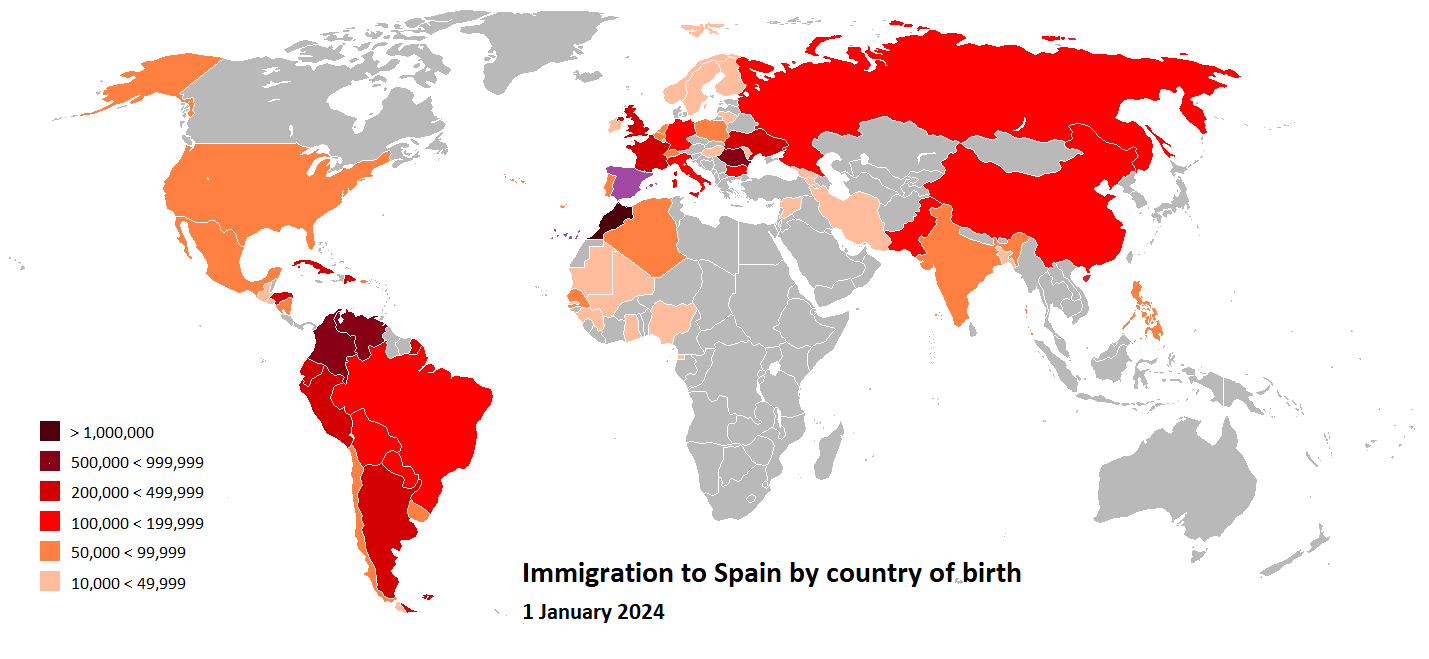Map of Migrants in Spain by Country 2024


David Chen
Data Visualization Specialist
David Chen is an expert in transforming complex geographic datasets into compelling visual narratives. He combines his background in computer science ...
Geographic Analysis
What This Map Shows
The "Map of Migrants in Spain by Country, 2024" provides a comprehensive overview of the diverse origins of migrants residing in Spain. This visualization highlights the various countries from which people have migrated to Spain, reflecting current demographic trends and the socio-economic factors driving migration in recent years. It’s not just a collection of numbers and countries; it tells a story about human movement, cultural exchange, and the shifting landscape of demographics within Spain.
Deep Dive into Migration Patterns in Spain
Migration is a complex phenomenon influenced by numerous factors, including economic opportunities, political stability, and social networks. Spain has long been a destination for migrants, attracted by its favorable climate, rich culture, and the promise of a better life. In 2024, the migration trends continue to evolve, shaped by global events, economic conditions, and Spain's own policies towards immigration.
Interestingly, Spain serves as a critical entry point for migrants from North Africa, particularly from Morocco, which is the largest source of migrants in the country. The geographical proximity of Morocco to Spain makes it a natural gateway, with many crossing the Mediterranean Sea or the Strait of Gibraltar in search of economic opportunities or fleeing political unrest.
However, the map also reveals significant numbers of migrants from Latin America, especially from countries like Venezuela, Colombia, and Ecuador. The ongoing political and economic crises in these nations have led many to seek refuge and a better quality of life in Spain, where historical ties and shared language facilitate their integration.
Moreover, the map highlights a growing number of migrants from Eastern Europe, particularly from Romania and Bulgaria. These countries have seen substantial migration to Spain as their citizens seek work in various sectors, including agriculture, construction, and services. The EU’s freedom of movement policy has facilitated this trend, allowing citizens from member states to easily relocate for employment and better living conditions.
It's also worth noting that the migrant demographic is not homogenous. While many are young workers, there is also a significant number of families and older individuals seeking to reunite with relatives already settled in Spain. The diversity of the migrant population contributes to a rich cultural tapestry, influencing everything from culinary trends to community festivals.
Regional Analysis
When analyzing the map regionally, it becomes clear that some areas in Spain have higher concentrations of migrants than others. For example, Catalonia, particularly Barcelona, is a hub for migrants from Latin America due to established communities and job opportunities in various sectors. The city’s vibrant cultural scene and language similarities make it an attractive destination.
In contrast, Andalusia shows a significant presence of North African migrants. Cities like Algeciras and Málaga are key entry points, given their proximity to Morocco. The agricultural sector in Andalusia also attracts many workers from this region, who find employment opportunities in the fields.
Madrid, as the capital, presents a mixed demographic of migrants from various backgrounds, including Sub-Saharan Africa, Eastern Europe, and Latin America. This diversity is reflected in the city’s neighborhoods, which are often characterized by multicultural influences and vibrant communities.
Interestingly, the Balearic Islands have a notable number of migrants from the UK and Germany, driven by tourism and the expatriate lifestyle. This contrasts sharply with mainland trends, showcasing how geography and economic activities shape migration patterns.
Significance and Impact
Understanding the patterns of migration in Spain is crucial for several reasons. Firstly, it informs policymakers about the needs and contributions of migrant populations, which can improve integration strategies and social services. As migration continues to play a significant role in Spain's demographic landscape, recognizing the challenges and opportunities presented by this diversity is essential.
Furthermore, the social implications of migration are profound. Migrants not only fill labor shortages but also enrich the cultural fabric of society. However, this can also lead to tensions, especially in times of economic downturns. The ongoing debates around immigration policies in Spain reflect the broader European context, where migration remains a contentious issue.
As we look to the future, trends suggest that the number of migrants in Spain may continue to rise, influenced by global crises, climate change, and shifting political landscapes. The ability of Spain to adapt to these changes will be key to ensuring social cohesion and economic stability. Have you ever wondered how these dynamics will shape the future of cities like Madrid and Barcelona? The story of migration in Spain is far from over, and it will continue to evolve, shaped by the dreams and aspirations of those who seek a better life.
Visualization Details
- Published
- August 17, 2025
- Views
- 118
Comments
Loading comments...